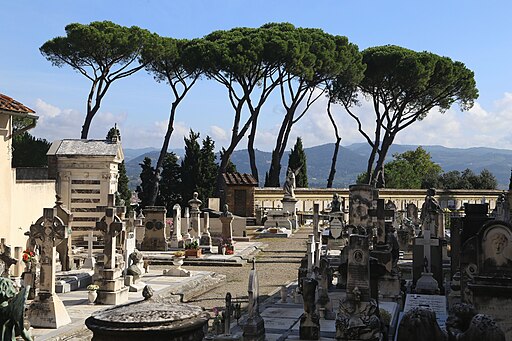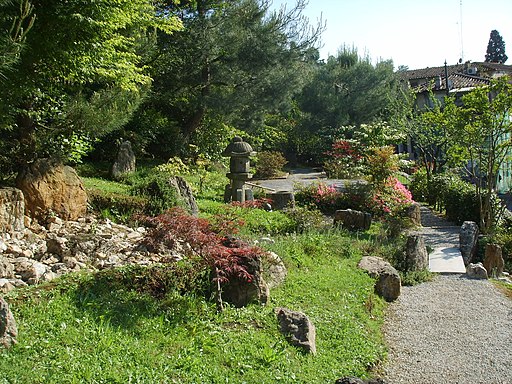From the garden you can enjoy the most beautiful panorama of the city, with views of the Ponte Vecchio, the Duomo Santa Maria del Fiore, the Uffizi, Santa Croce and the Palazzo Vecchio.
|

|
| Giardino delle rose, with incredible views over Florence [1] |
Giuseppe Poggi and the urban renewal of Florence |
|
|
Giuseppe Poggi (3 April 1811 – 19 March 1901) was an Italian architect, mainly active in Tuscany. A native of Florence, he received numerous commissions from the city's upper bourgeoisie for renovations of palaces and gardens.
The viale dei Colli
From 1864 he designed the city's urban renovation, which included the demolition of the walls, and the creation of the Viali di Circonvallazione to encircle the city. At the sites of the former gates of the city, he created scenographic squares, such as the Piazza Cesare Beccaria and the Piazza della Libertà. He later designed the viale dei Colli, a panoramic walk ending with the Piazzale Michelangelo.
The architect meticulously described the viale dei Colli in the seventh chapter of his report on the extension of Florence. He deliberately designed picturesque effects, right down to the promenade to the church of San Miniato al Monte and the Cimitero delle Porte Sante cemetery. The Piazzale Michelangelo has been conceived as the highlight of the Viale dei Colli.
Along the walking route, which has a slope between 1 and 3.8%, Poggi provided some gardens with arbors and chalets that at the time offered "all kinds of recreation". One of these gardens was the Giardino delle rose (The Rose Garden).
Giuseppe Poggi died at Florence in 1901.
|
|
 Viale dei Colli and panorama of Florence in a nineteenth-century photo Viale dei Colli and panorama of Florence in a nineteenth-century photo
|

Florence, Photo gallery
|
|
|
![Piazzale Michelangelo [Magnificent View on Ponte Vecchio]](https://upload.wikimedia.org/wikipedia/commons/thumb/4/4f/Florence_from_Piazzale_Michelangelo_-_panoramio_%286%29.jpg/512px-Florence_from_Piazzale_Michelangelo_-_panoramio_%286%29.jpg) |
|
 |
|
 |
Piazzale Michelangelo [Magnificent View on Ponte Vecchio]
|
|
Piazzale Michelangelo, con veduta del Duomo di Santa Maria del Fiore |
|
Panoramic view from Piazzale Michelangelo on Santa Croce |
 |
|
 |
|
 |
Piazzale Michelangelo |
|
Piazzale Michelangelo, con veduta del Ponte Vecchio e di Palazzo Vecchio |
|
Piazzale Michelangelo al tramonto, con veduta del Duomo di Santa Maria del Fiore, degli Uffizi, di Santa Croce e di Palazzo Vecchio
|
 |
|
 |
|
 |
| San Miniato al Monte, Cimitero Porte Sante |
|
Giardino delle rose, Firenze |
|
San Miniato al Monte
|
 |
|
|
|
|
| |
|
|
|
|
Strolling in Florence | Walk from Ponte Vecchio to Piazzale Michelangelo
Beautiful walk in one of the most authentic neighborhoods of Firenze, San Niccolò. The atmosphere of an authentic Florentine neighborhood still remains here.
|
|
 |
| |
|
Giardino Bardini, View east inbetween Porta San Niccolo and Piazzale Michelangelo
|
Transport
Timetables and routes - ATAF | Map
You can view the bus routes at the Florence transit site: www.ataf.net/en/ataf.aspx?idC=2&LN=en-US
|
|

|
| |
|
|
|
Bus trasport in Florence
|
Bibliography
Rinaldi, Niccolò (2012). "Rose Garden". Secret Florence. trans. Jeremy Scott (2 ed.). Versailles: JonGlez. p. 286. ISBN 9782361950446.
Agostini, G. & Casagli, Nicola & Delmonaco, Giuseppe & Fanti, Riccardo & Focardi, P. & Margottini, Claudio. (2002). Landslide Monitoring and Cultural Heritage At Risk: The Case Study of San Miniato Hill In Florence.
"Giardino delle Rose". Diladdarno: Firenze oltre il fiume. Retrieved 19 May 2016.
Montanari, Laura (29 September 2011). "Nel giardino delle visioni l'ultimo desiderio di Folon". Repubblica (in Italian).
|

[1] Foto di Sailko, licenziato in base ai termini della licenza Creative Commons Attribuzione-Condividi allo stesso modo 3.0 Unported
[2] Agostini, G. & Casagli, Nicola & Delmonaco, Giuseppe & Fanti, Riccardo & Focardi, P. & Margottini, Claudio. (2002). Landslide Monitoring and Cultural Heritage At Risk: The Case Study of San Miniato Hill In Florence.
[3] Rinaldi, Niccolò (2012). "Rose Garden". Secret Florence. trans. Jeremy Scott (2 ed.). Versailles: JonGlez. p. 286. ISBN 9782361950446.
|
| |